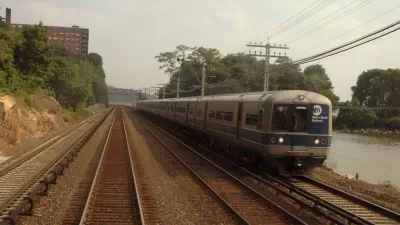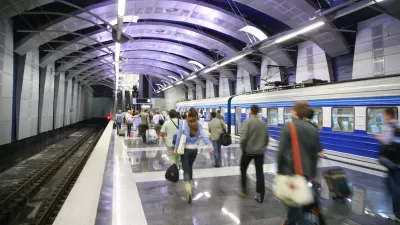Yonah Freemark tackles the big question, as House Republicans deliver an agenda to reduce federal spending that proposes deep cuts to transit spending.
The answer? Rural and non-urban districts tend to elect Republicans, and urban centers elect Democrats:
"The two parties generally fight it out over the suburbs. In essence, the base of the two parties is becoming increasingly split in spatial terms: The Democrats' most vocal constituents live in cities, whereas the Republicans' power brokers would never agree to what some frame as a nightmare of tenements and light rail."
Freemark has some excellent graphs over at The Transport Politic showing just how split the nation is on urban/rural lines and how that correlates to political party preferences.
Freemark writes, "Republicans in the House of Representatives know that very few of their constituents would benefit directly from increased spending on transit, for instance, so they propose gutting the nation's commitment to new public transportation lines when they enter office."
FULL STORY: Understanding the Republican Party’s Reluctance to Invest in Transit Infrastructure

Planetizen Federal Action Tracker
A weekly monitor of how Trump’s orders and actions are impacting planners and planning in America.

Maui's Vacation Rental Debate Turns Ugly
Verbal attacks, misinformation campaigns and fistfights plague a high-stakes debate to convert thousands of vacation rentals into long-term housing.

San Francisco Suspends Traffic Calming Amidst Record Deaths
Citing “a challenging fiscal landscape,” the city will cease the program on the heels of 42 traffic deaths, including 24 pedestrians.

Defunct Pittsburgh Power Plant to Become Residential Tower
A decommissioned steam heat plant will be redeveloped into almost 100 affordable housing units.

Trump Prompts Restructuring of Transportation Research Board in “Unprecedented Overreach”
The TRB has eliminated more than half of its committees including those focused on climate, equity, and cities.

Amtrak Rolls Out New Orleans to Alabama “Mardi Gras” Train
The new service will operate morning and evening departures between Mobile and New Orleans.
Urban Design for Planners 1: Software Tools
This six-course series explores essential urban design concepts using open source software and equips planners with the tools they need to participate fully in the urban design process.
Planning for Universal Design
Learn the tools for implementing Universal Design in planning regulations.
Heyer Gruel & Associates PA
JM Goldson LLC
Custer County Colorado
City of Camden Redevelopment Agency
City of Astoria
Transportation Research & Education Center (TREC) at Portland State University
Jefferson Parish Government
Camden Redevelopment Agency
City of Claremont




























